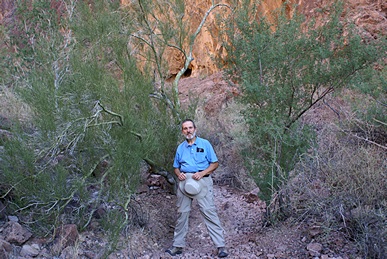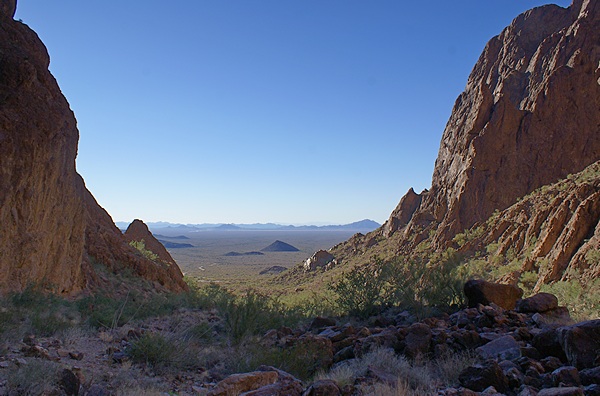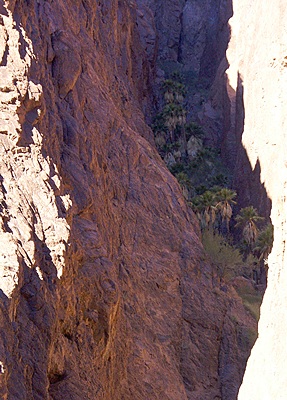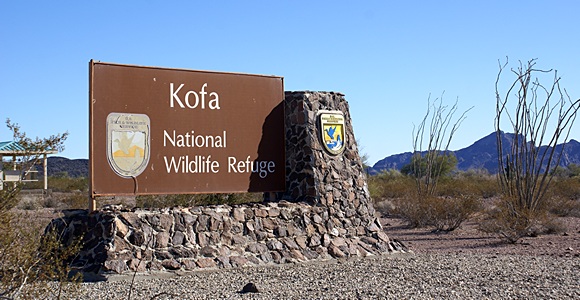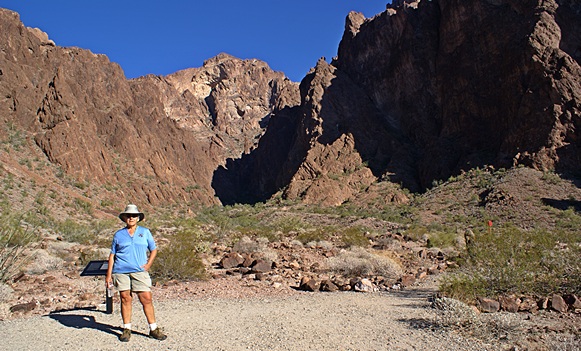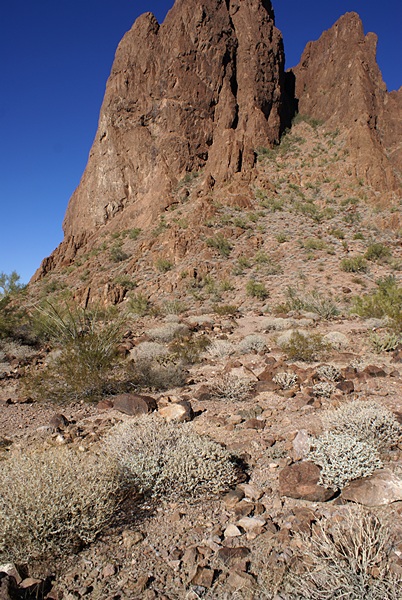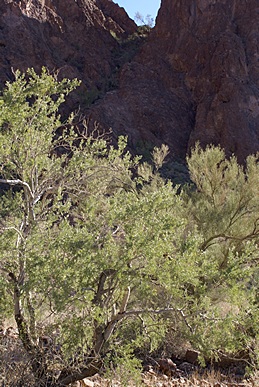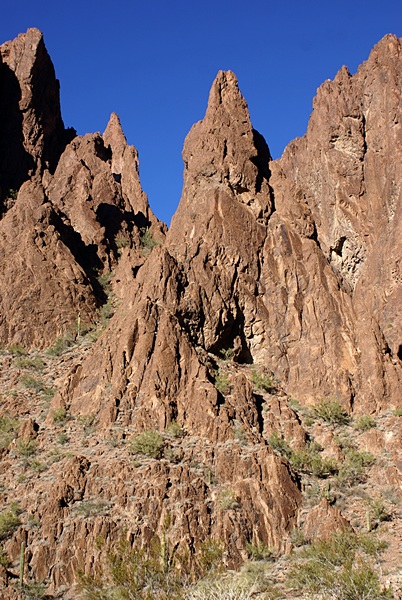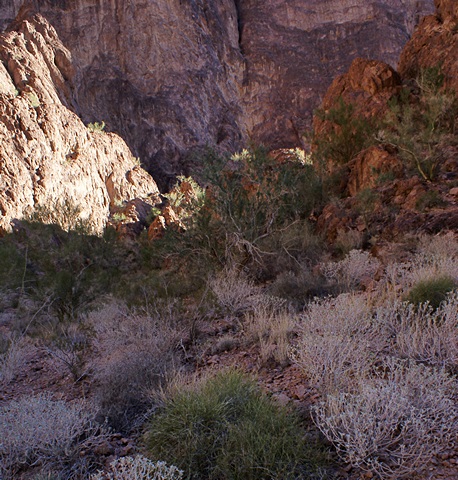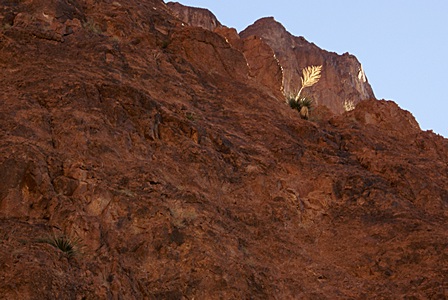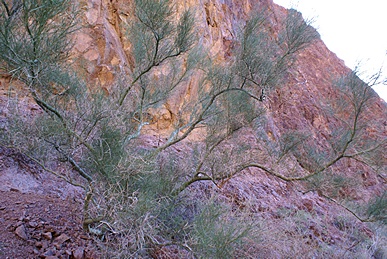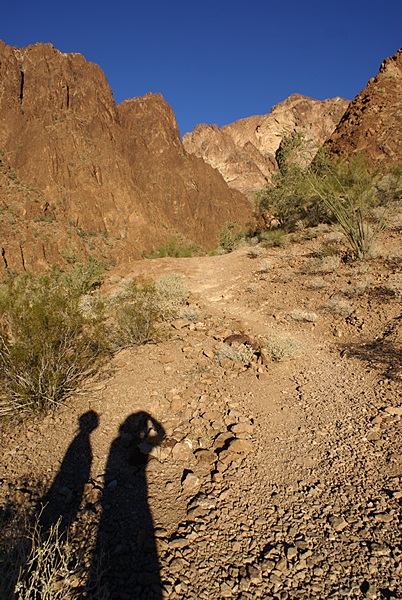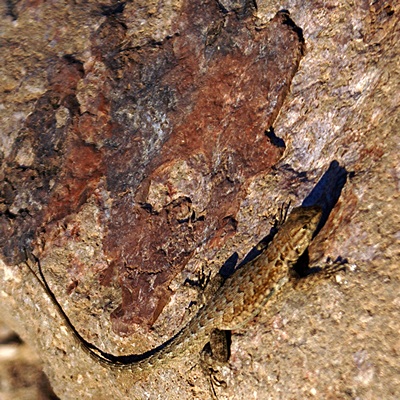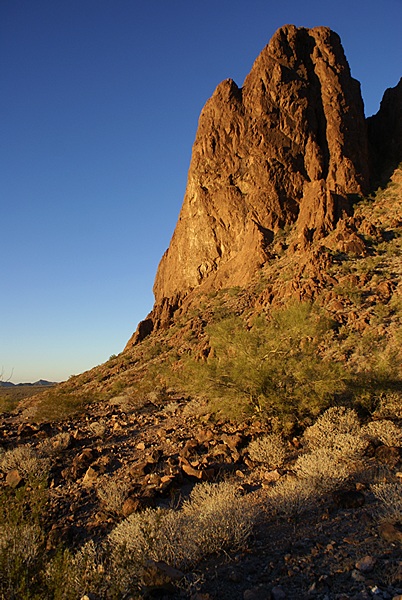2015/01/27 (T) Ahhh, Mexico
We packed quite a bit into today. After having toast and coffee for breakfast we drove to Yuma through heavy cloud cover and fog. It made for an interesting and beautiful drive, but we did not pull off the road to take pictures. There is often a tension between the need to get somewhere and the desire to stop and take photographs. Today the destination took precedence.
When we got to Yuma we drove around looking for the Main Street that led to the heart of downtown and Yuma Territorial Prison. This was only the second time we had been in Yuma and the first time I had driven here and I did not quite remember how the streets ran, which is unusual for me. Yuma is not that big of a town and I was able to get oriented fairly easily with the help of the GPS map. I missed a turn, however, and we ended up driving over the single lane bridge on the Ocean to Ocean Highway. We stopped at a Casino just short of the California border, turned around, and went back over the bridge. Being single lane the traffic is controlled by stop lights on each end.
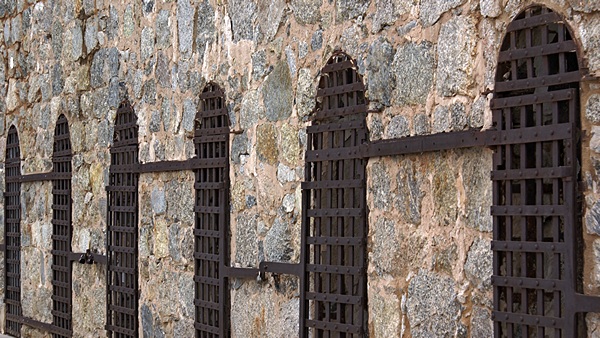
Main cell block, 1875 Yuma Territorial Prison. Yuma, AZ.
I made the correct turns this time and got us to the parking lot for the 1875 Yuma Territorial Prison State Park. Very little of the original prison remains, but there is enough of it to give a feeling for what it was like. The small museum does a good job of telling the story, but a tour guide (from Canada) helped fill in details and answer questions. Although part of the Arizona State Parks system, it is operated by a local organization staffed by volunteers.
The prison and the Quartermaster State Park are the two main tourist attractions in Yuma. Beyond those two things it is the closest city to Quartzsite with a good selection of major retailers. Yuma is also home to Marine Corps Air Station Yuma and the U. S. Army Yuma Proving Grounds are just 20 miles north of town. But the thing that interested us is that Yuma is the wintertime lettuce bowl of North America. The flat topography and rich soil, watered by an extensive irrigation system fed by the Colorado River and worked by Mexican laborers, spreads as far as the eye can see and supports a vast crop of a large variety of leafy green vegetables.
From the prison I drove west on I-8, almost immediately crossing the Colorado River into the extreme southeast corner of California. Eight miles later we exited onto CA-186 and headed south through the Quechan Indian Reservation to the U.S./Mexican border crossing at Los Algodones. We parked in the Indian owned/operated lot and walked across the border into Mexico; our first ever visit to our southern neighbor. We found it interesting that no one checked us on entry.
Los Algodones is an interesting and unusual little town. It exists because of tourists from north of the border and has been developed to serve some specific needs of those visitors. It has the highest concentration (and number) of dentists and optical shops of any place on earth and quite a few pharmacies too. Many American and Canadian RVers come to this area during the winter months not only for the warm, dry climate, but for annual dental work, eye exams, glasses, and both prescription and over-the-counter drugs. The vast majority of them park on the U. S. side and walk across the border.
We walked the streets of Los Algodones for an hour or more and finally settled at the Pueblo Viejo restaurant for lunch. Linda and Marilyn had bean burritos and bottled mineral water. I made the riskier choice and had a green salad and deep fried peppers. The peppers were thinly sliced jalapeños mixed with sliced onions. Linda and Marilyn had some too, but between the three of us we did not finish them; too hot. At least they were authentic! Puerto Viejo was the #2 rated restaurant on Trip Advisor and everything we read said the town was safe, including the food. (The #1 rated restaurant was a sushi bar.)
The restaurant was just across the street from the port of entry so we walked over there and got in line behind a couple of hundred other people. It took 30 – 40 minutes to reach the customs agent, but the sidewalk was shaded by an overhanging sunscreen and lined with benches so it was comfortable enough. When it was finally our turn we each cleared customs in less than a minute and were finally back the U.S.A. We got to use our credit card size passport cards for the first time.
We drove back to Yuma and found the major outdoor shopping mall where I stopped at Best Buy to look for a lens hood and cap for my Sony alpha kit/zoom lens (DT 3.5-5.6/18-70mm) but they did not have any compatible products.
The drive home up US-95 was very different than the drive down. The clouds and fog were gone and we had a clear view of the mountains to either side of the valley. Once we were north of the U. S. Army Proving Grounds the land to the east of the highway was part of the KOFA a National Wildlife Refuge, one of the largest in the country at over 650,000 acres. (KOFA stands for “King OF Arizona, a large mine that once operated in this area.) Between the Proving Grounds and the BLM land south of Quartzsite there are four roads that lead east into the refuge. Overnight camping is permitted within 100 feet of the roads unless otherwise posted, but we saw very little evidence of anyone out there. It is, however, a large, remote, area without any services so it only appeals to a certain kind of boondocker, such as those seeking solitude and a semi-wilderness experience. I say “semi-” because if you can drive there in a 40′ motor home, or a pickup truck pulling a 35′ 5th wheel trailer, it is not wilderness by definition.
About 20 miles south of Q we turned off onto the KOFA NWR road leading to the Palm Canyon trailhead. The canyon is a huge crevice in the 5,000 foot tall mountain and is home to the only indigenous Palm trees in Arizona. The trailhead was another seven (7) miles in from the highway and the trail into the canyon was a half mile hike from there, so we will come back another time earlier in the day and do that. The sun was getting lower in the western sky and the top of the very large mountain to our east was obscured by clouds so the situation was setting up for the possibility of good photographs. We drove in about 3 miles (at 10 – 15 MPH) and then pulled off the road at a good vantage point to take photos. We were rewarded for our decision as the sun bathed the mountains in glorious, warm light.
Although the road was generally good gravel and clearly defined we wanted to leave the refuge and get back to the coach while it was still daylight. As often happens the sunset lingered and the colors deepened as we drove. One of the challenges with shooting sunsets is that if you hang in there until it is over, you have to pack up your gear and extract yourself from the location in the dark. Unless, of course, you are backpacking and have already pitched your tent right there. The same goes for sunrise photography, only in reverse.
Back at the coach we had various snacks for dinner. Butch brought the mail over and we chatted for a few minutes. I worked on several e-mails from Gary at BCM, and Bob from our FMCA Freethinkers chapter. I transferred photos from my camera to my computer and backed them up to the NAS. I then used MS-ICE to create a couple of panoramas from today’s trip and used FIV to post-process them along with a photo of the mountain at sunset. By the time I was done it had been a very long, but interesting, productive, and satisfying day.
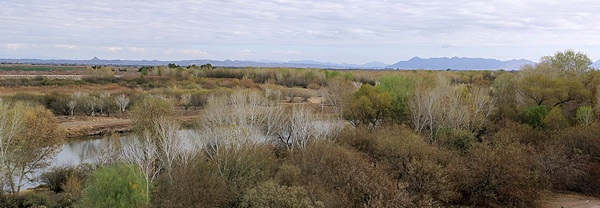
View looking north from the 1875 Yuma Terriorial Prison State Park, Yuma, AZ.
2014/01/28 (W) Boomerville
After a light breakfast Linda and Marilyn drove to the local Farmers Market and also spent a little time looking around Desert Gardens. Linda bought some asparagus and a Romanesco brocciflower, which is a cross between broccoli and cauliflower. It grows in a fractal manor based on a Fibonacci number sequence which makes it visually very interesting.
While they were gone I worked on survey items for the FMCA NEC member education survey and suggested a minor change to the seminar categorization spreadsheet that Jim A. had prepared. I had planned to work on my blog posts for the third week of October (2014) but did not get to those before lunch.
After lunch Linda and I drove out to the BLM Scaddam 14-day area east of town and found the site where Boomerville was set up all last week. Most of the rigs had pulled out. Many of them were also geocachers and moved to the Roadrunner area south of town. We were looking for Bill Stewart and Lynn Pearlmutter from our FMCA Freethinkers chapter and finally spotted their Tiffin Phaeton. We sat and chatted for over an hour and then headed back to camp where Marilyn had been re-treating in our absence. I think it has been a good visit for her.
I worked on consolidating seven blog posts from the third week of October while Linda started preparing dinner. For Marilyn’s final dinner meal (dare I say ‘last supper’) Linda made her mock stroganoff. No, she did make Marilyn mock her stroganoff, she made a vegan version of stroganoff and served it over white rice, the way I like it. She also steamed the Romanesco brocciflower. The taste and texture was mostly cauliflower-like so I seasoned my pieces with a little white vinegar, which is the way I like my cauliflower.
While the ladies played Scrabble online I worked on the blog post and got the pictures selected and edited. I was up very late again but I got it posted before I went to bed. I was also having trouble logging in to RVillage using the Google Chrome browser. I tried Firefox and got in without difficulty and was able to navigate the site. Remembering that Butch had a similar problem a couple of weeks ago with a different website, I cleared the browsing history (cache) for the last week and tried again. That resolved the problem, at least for now. RVillage support had indicated that they were having login issues with the site, so my browser may have cached a bad page. I primarily use Chrome to browse, so the bad page had probably not been cached in Firefox.
I spent some time on e-mails dealing with an issue we have in our FMCA Freethinkers chapter. I updated Piriform CCleaner on my computer and ran it. I then opened Piriform Defraggler, checked for updates, and started it. It said the remaining time was “> 1 day” so I let it run and went to bed.
Although it was late I worked on the draft of my blog post for yesterday as I had only had time to outline it on my iPad. I then worked on this post. Even though I am still way behind in uploading posts to our WordPress website I have to write them each day or I lose the details. It also takes a fair amount of time, and if I get behind I risk not being able to catch up. I don’t have to do this at all, of course, but it’s something I want to do and enjoy doing. I just don’t like being so far behind.
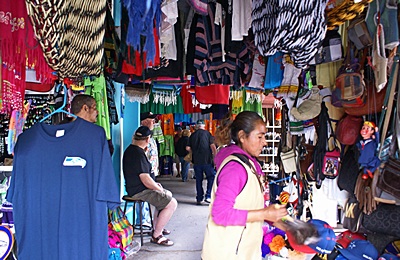
One of the many covered sidewalk market areas in Los Algodones, Mexico.
2015/01/29 (R) The Flying Nun
We have had an excellent visit with Marilyn since she arrived on the 22nd with a nice mix of local activities, distant sight-seeing, and quiet time at home to visit and allow her to read, rest, and contemplate. She flew back to St. Louis, Missouri this afternoon but before she left Linda made vegan blueberry pancakes for brunch.
Marilyn’s flight home was at 4 PM MST from the Phoenix airport, which is over 130 miles east of Quartzsite, so they left at noon to get her there in plenty of time. I stayed home to work and decided to reconcile the financial statements for our FMCA Freethinkers chapter with the copies of the bank statements I received yesterday from the Treasurer, who lives in Chico, California. While I was at it I updated my financial statements and dues analysis worksheets and the master roster. Linda called at 2:30 PM to say she was starting back to Q but that traffic was very heavy and she might not be back until after 5 PM. That proved to be a very accurate estimate.
We had an early dinner that that consisted of a large salad and an equally large glass of Sangria. I continued to work after dinner dealing with e-mails and then editing together the blog posts for October 23 through 29 into a single post. I got the post compiled but it was too late (I was too tired) to select and process photos, much less upload the whole thing to WordPress, so I went to bed.
2015/01/30 (F) Regen Aggravation
Rain was forecast for last night and into today and that forecast turned out to be accurate. It started raining around 11 PM and rained through the night and into mid-late morning. The precipitation rate was never very high but the rain was persistent. Even after it quit raining heavy clouds filled the valley and obscured the mountain tops in all directions. There was a lower chance of showers for this evening after which the system is then supposed to start clearing out.
Marilyn does care for breakfast cereals or things that look, taste, or feel like milk, so we tended to have toast for breakfast while she was here (except when we had vegan cinnamon rolls and vegan blueberry pancakes). This morning we returned to our normal breakfast of granola, fruit juice, and coffee. After breakfast we both had work to do and set both of our laptops up on the dinette table.
Linda got a package yesterday from the bakery via UPS with work papers related to the 12th accounting period of the 2014 fiscal year. This was also the first accounting period in which the bakery was running only on the new software. Linda did the software configuration and conversion in September, October, and November of 2014 and the 12th accounting period corresponds approximately to the month of November.
My “work” was completing my blog post for October 23 – 29, 2014. I selected 10 photographs for the post that were representative of the work described in the narrative, visually interesting, and technically OK. I uploaded the text to WordPress and then uploaded, captioned, and inserted each image. I got finished about the same time Linda got tired of staring at numbers and made pocket pita sandwiches for lunch. She went for a long walk afterwards and I turned my attention to our fresh water system.
I knew we were below 1/3rd of a tank of fresh water based on the monitor in the house systems panel. I checked after lunch and we were at ~1/6th of a tank (~20 gallons). The last time I filled the tank I checked the hardness afterwards and it was higher (3.0 grains per gallon, or gpg) than it had been. After the last regeneration (recharge) it measured 1.5 gpg and continued to give that reading after each of the next few fill ups. (It should have measured 0 gpg but I was not able to get it recharged to that extent.) We have been keeping a log of the dates, gallons, and hardness but I had not yet analyzed the data so I added 100 gallons to the tank. Afterwards I checked the hardness of the water coming out of the softener and it measured 25 gpg, which is the low end of the very hard water range. Oops.
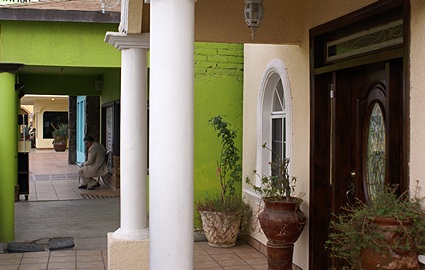
Although Los Algodones, Mexico was crowded and bustling with tourists from north of the border there were many quiet places like this.
I did not want to leave that water in the tank and run it through our plumbing and fixtures, but I had to regenerate the water softener before I could do anything else. I removed the filter from the housing on the input of the water softener. It was brown all the way through from the outer surface to the inside, so it needed to be replaced even though I had just installed it when I did the last regeneration. Quartzsite city water is safe to drink but in addition to being very hard it has a lot of sediment in it. Butch also thinks it is over-chlorinated and Jim L., who qualifies as a local, just doesn’t think it tastes good. The water we drink and cook with in the coach goes through three filters and a softener before it reaches our lips so we do not have any issues with it.
I put the special recharge tube into the filter housing and filled the bottom half of the housing around the outside of the tube with solar salt. I then poured half of a container of Morton table salt (non-iodized) on top of the solar salt. I aligned the center tube with the center of the head and threaded the housing onto the head. I ran water through the filter housing and then through the softener until I got a strong salty taste out of the softener. The instructions that came with the unit say to run water through the filter housing and out the softener until the saltiness is gone, but it gives no indication of how strong or weak the flow should be or how long it should take.
[When salt (NaCl) dissolves in water (H2O) sodium ions become available. The special media in a water softener has an affinity for dissolved ions. Recharging the softener dislodges the calcium (Ca) and magnesium (Mg) ions from the media and replaces them with sodium (Na) ions as a result of the supersaturated saltwater brine. During normal operation the sodium (Na) ions in the softener are exchanged for the calcium (Ca) and Magnesium (Mg) ions in the water. “Soft” water is not demineralized water, but the sodium (Na) ions do not cause the scale and build up in plumbing systems that the harder calcium and magnesium ions do.]
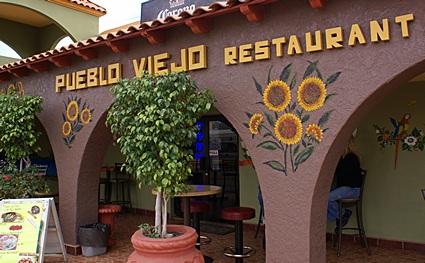
This is where we ate lunch in Los Algodones, Mexico.
When the water coming out of the softener was very salty I reduced the flow to a small amount and let run. I lost track of exact time, but I eventually shut the flow off, shut off the incoming water, and unscrewed the housing. It still had salt in it; not as much as when I started, but too much to be done.
[It takes a certain quantity of salt to produce enough sodium ions (Na) to completely recharge a softener of some given capacity. Softeners do not treat a certain number of gallons of water before needing to be regenerated; they remove a certain number of grains of hardness based on the design. The harder the water coming in the fewer gallons that can be processed. Softer water in, more gallons processed. When you understand the science involved, it is really quite simple.]
I stirred the salt in an attempt to dissolve it and put the housing and tube back on the head and ran more water through it. One of the problems with this arrangement is that I am starting with very hard water while trying to regenerate a water softener, but there is no easy way around that. The other problems is that I do not have a sediment filter ahead of the softener. If particulates are allowed to enter the softener and accumulate they will reduce and eventually destroy the effectiveness of the ion exchange media. This is a design flaw that is easily remedied by adding another filter housing between the sediment filter and the inlet of the softener. I will probably rig up something like this when I redo the water bay and use a clear housing so I can see when the salt is gone. Assuming, of course, that I do not replace the entire system with one like Butch’s.
After fooling around with this for a while I tested the water coming out of the softener and it was still up around 15 gpg. It appeared that nothing I had done for the last two hours had made any difference. I removed the housing yet again and added an entire 26 oz. container of Morton non-iodized table salt. I ran the water until it came out of the softener very salty and then shut it off.
I set the timer on my phone for one hour and drove down to the Tyson Wells market area on Kuehn Street to buy a T40 GAC (granulated activated carbon) filter from the Water Filter guy. While I was down there I stopped and bought a loaf of Barry’s Basic Bread. When I got back to the coach I ran the water for 30 seconds, shut it off, and set my timer for 20 minutes. I repeated this cycle for another hour and then set an outlet valve on the softener to emit a slow stream and let it continue to run. I periodically tasted the water coming out and eventually it did not have any saltiness. I checked it with a test strip, my third of the day, and it finally tested at 1.5 gpg. Evening was approaching and I once again found myself in the position of having to finish this process in the dark, so I abandoned any hope of getting it fully recharged to zero (0) gpg, if the unit is even capable of that.
I opened the drain valve on the fresh water tank part way and let the entire 120 gallons drain out. I did not like wasting that water, but I did not want it in our system. I also do not like the amount of time and water it seems to take to regenerate our softener, but it’s what we have for now. At least we are parked on gravel so all of the salty water can just soak in without harming anything. In an RV resort with landscaping we would have to be careful not to discharge the brine onto the grass or plants. The salt water is also not great for septic systems, but in sticks-n-bricks homes it usually ends up in one of those two places.
I installed a new 5 micron melt-blown polypropylene sediment filter in the pre-softener housing and screwed it back on to the head. I let filtered water run through the softener and onto the ground to flush any remaining brine out of the tank. While that process was taking place I turned my attention to the post-softener filter.
We have a filter housing built into the water bay of the coach. Water enters the coach through a garden hose connection then (presumably) passes through a check valve before going through the filter. From there it runs throughout the coach to all of the fixtures and the Aqua-Hot. One of the fixtures is the fill valve for the fresh water tank. When the onboard 12VDC water pump is used it simply takes water out of the fresh water tank and pressurizes the entire system the same way the shore line does. The pump has a check valve to prevent the pressure from an external connection from forcing water backwards through the pump.
The filter housing is hidden behind a beauty panel that makes it awkward to access and service but I managed to get the housing loose and to remove it without spilling too much water. The installed filter was just a pleated sediment cartridge but it was basically clean so either sediment was not getting this far or was small enough to pass through. I installed the T40 GAC cartridge and put the housing back on the head. I then turned off the water coming into the softener and connected the output to the hose from the fresh water inlet on the coach. The directions said to flush out the T40 with at least five gallons of tap water before using the water so I filled the kitchen sink half full while running off of the shore line.
I started this process at 1 PM. It was now 6PM and I was finally ready to fill the fresh water tank. The T40 filter cartridge does not have a micron rating but it was a rather snug fit in the housing and the design looks like it could constrain flow rates. I opened the fill valve for the fresh water tank and set my phone timer to 40 minutes.
While the tank was filling I started putting the dump and fill data we have been logging into a spreadsheet. Our softener tank is the same size as Butch and Fonda’s, which is labeled as having a 10,000 grain capacity. Our data indicated that the last 100 gallons we added took our total from 515 to 615 gallons. We knew we had obviously run too much water through the softener based on the first hardness test today, but this data was confirming that we had, at most, a 10,000 grain capacity tank. Given the 25 gpg city water coming out of the tap we will need to regenerate the softener somewhere between 400 and 500 gallons. Given the aggravation involved in trying to recharge our unit I doubt that it will be a long-term solution for us. It simply should not take that much time to do something so simple, especially when it has to be done so often.
At the end of 40 minutes the fresh water tank was 3/4s full so I set the timer for another 10 minutes. With the current filter setup the flow rate into the tank appears to be about 2.5 gallons per minute. The Shur-Flo 4048 pump has a 4 GPM maximum flow rate, so that is another reason we run off the tank rather than the shore line.
By the time the tank was full it was too late to actually cook dinner so Linda heated up an Amy’s Barley Vegetable soup and put out some crackers and peanut butter; easy but delicious.
I worked on this blog post after dinner, spent a little more time with my water usage spreadsheet, dealt with some critical e-mail, and went to bed way too late. But then, I did not have to be up by any certain time and I can take a nap tomorrow if needed.
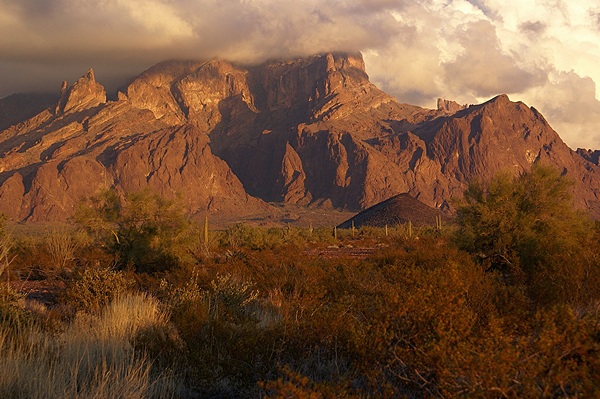
Palm Canyon at sunset. KOFA National Wildlife Refuge about 20 miles south of Quartzsite, AZ.
2015/01/31 (S) January LTT
The last day of January dawned under cloudy skies. We are well past the midpoint of our first winter in Quartzsite and continuing to enjoy our time here. The “Big Tent” RV Show has been over for a week and the BLM STVAs (free, 14-day limit) have thinned out as the visitors who were here for two weeks surrounding the ‘show’ have moved on. There are still lots of RVs in the BLM LTVAs (fee-based, up to 180 days) but those are longer-term visitors who, like us, are here for ‘the season.’ The commercial RV Parks in town still have healthy occupancy, but the ‘vacancy’ signs are out once again. There are still plenty of vendors set up in the various markets along Kuehn Street and the flea markets along west Main Street are still operating. There is still traffic but not the parade of RVs and gridlock of the previous couple of weeks. There is still lots of activity but the frenzy appears to be over. Experienced visitors have told us that we will notice a gradual slow down as we move through February into March. We will also notice a general warming of temperatures.
A small bird of prey has been active around our campsite for the last few weeks, probably longer, and was finally successful in catching something to eat this morning; at least this was the first time that were aware of it. It took a small bird down by the seed block that attracts various birds and rabbits to our ‘front yard’ and sat where we could see it while it ate. WE identified it as an American Kestrel (Sparrow Hawk) and the small bird it caught was indeed a sparrow. The American Kestrel ranges from 4 to 10 ounces in weight and has a wingspan up to 24 inches with the larger birds being the mature females. It is the only Kestrel native to North America and is the first one we have had a good look at in the wild. It normally eats large insects, small mammals, and lizards, but will take smaller birds if it can, thus the name. They also have the unusual ability to hover given a very slight amount of wind.
We planned to stick around camp this weekend and work on various tasks so after breakfast Linda started a load of laundry. I like laundry day because I get to stay in my sweat clothes while my regular ones get laundered. Between loads Linda continued working on accounting for Butch and Fonda and for the bakery. I prepared a 4-day and a 7-day consolidated blog post and then worked on reformatting and expanding some more survey items for the FMCA national education committee. I received a draft report/recommendation from Jim A. for the seminar classification work we have been doing so I went through it, made minor corrections, and added several comments for his consideration.
Linda can only sit for so long so around 2 PM she made mock deli meat sandwiches for lunch with vegan cheese slices, lettuce, vegan mayo, and honey mustard on Barry’s Basic Bread. She then went for a long walk while I continued to work at computer-based tasks. She made it to the market area at Kuehn Street and Central Avenue and bought another loaf of Barry’s Basic Bread as we worked our way through the one we bought yesterday fairly quickly.
Butch installed his new TireTraker TPMS sensors yesterday. (I still need to install ours.) In the process he discovered that his Chevy Suburban spare tire only had 14 PSI of air pressure in it. Worse yet the valve stem on his bus spare was too damaged to get the sensor on. But the real problem was that one of the two attachments for the front bus bumper broke off. Four bolts had rusted through and snapped. This morning he looked at what would be involved it drilling out the pieces that were stuck in the threaded holes and decided that was not a job he could do on the road. He bought some metal strap and fashioned two loops around the front of the bumper and behind the mounting plate and bolted the ends of each to draw them in tight. When he was done the bumper closed and opened just fine and aligned well with the body when closed. I joked that this might be another “Long-Term Temporary” repair, or “LTT” for short, and suggested that we should coin the phrase.
Linda made a new dish for dinner, Savory Orange Roasted Tofu and Asparagus. As the name indicates, it consisted of tofu cubes roasted in a mixture of miso, balsamic vinegar, and olive oil to which asparagus was added while roasting continued. A sauce is made from miso, balsamic vinegar, orange juice, and orange zest and mixed in to the roasted ingredients just before serving. She also made Farro with a little oil, salt, and pepper and served it as a side. It may be the first time we have had Farro all by itself rather than as an ingredient in a dish. It really is a wonderful grain. Clementine orange sections and Franzia Fruity Red Sangria completed the meal.
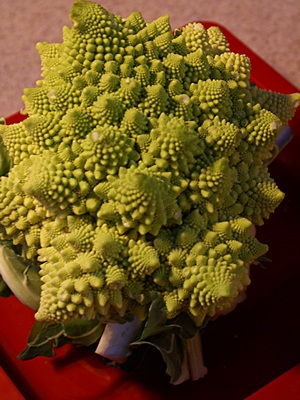
A Romanesco Boccliflower.
Towards the end of dinner I had a call from Neal Sunderland wanting to know if we knew of anyplace in Q where he and Nora could get prime rib (of beef) for dinner. An odd request to make of a vegan, perhaps, but we only just met during the Eagles International bus rally and he did not remember how we eat. Linda got on an iPad and did her best to find out what was in town. The problem with Q is that a lot of the restaurants close at 8 PM, or sooner if they run out of food. They were already driving when Neal called and he spotted a sign at the Stagecoach Restaurant on Main Street (B-10) for a prime rib special so they pulled in to the parking lot. I heard the hostess in the background tell Neal that they were out of the special. They had 37 of them available for dinner and they were all sold. Yeah, Q is like that.
I have been reading up on the WordPress.com Jetpack: Site Administration feature. It sounds very cool as it would allow me to manage multiple WordPress websites via my WordPress.com account. This includes self-hosted sites, which all four of mine are, plus WordPress.com hosted sites. I have the Jetpack installed on all four Websites but I have never activated the Site Management feature, which must be done from within the admin panel. I decided to activate it tonight on the FMCA Freethinkers website, hosted by iPower.com. The activation failed and took down the /WP-admin/control panel. The site is still there (structure/functionality/content) but I cannot get to the dashboard to do anything. I sent a support request to iPower and cc:d Bob Pelc, the President of the FMCA Freethinkers, who is the owner of the clubs iPower account. I also sent a support request to Jetpack and an e-mail to Larry (K8UT) seeking his thoughts on the situation. This was not how I wanted to end my day but there was little more I could do late on a Saturday evening, so I went to bed.
